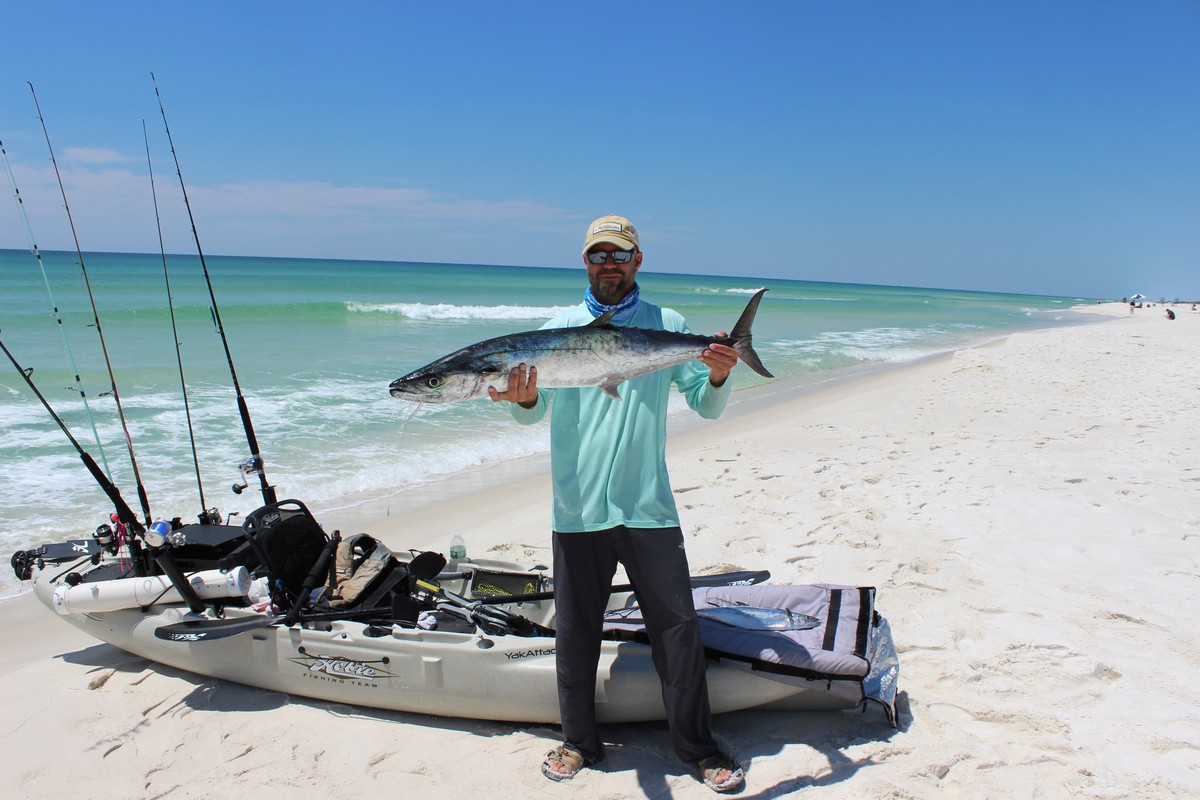
King mackerel rank among the top of the list for coastal offshore kayak anglers in the southeast. Sometime in early to mid April large amounts of bait will start to show up along the Florida Panhandle with schools of Spanish mackerel in tow. When this happens, the kings will not be far behind. King mackerel are extremely fun to catch and are plentiful in our waters from spring through the summer and even into the early fall in Pensacola Bay. Most years we will see a good number of large fish push through on the first run. These fish can be in the 20- to 40-pound class and offer even the most experienced kayak angler a memorable battle.
The key to finding king mackerel is finding large concentrations of bait. We target them around structure such as piers, buoys or channel markers, over artificial reefs, near live natural bottom and even just off the second sand bar of the beach. The most popular technique is slow trolling using the MirageDrive with live bait like a cigar minnow, blue runner (hardtail), goggle eye, threadfin or Spanish mackerel. At times it is more effective to use a weighted duster or downrigger to get your baits deeper in the water column. Pulling diving plugs or large rattletraps will also produce, but generally speaking these fish will be smaller.
The king mackerel bite is often best when there are overcast skies and texture on the water. In many cases, the rougher the better.

These fish are slash feeders, strike hard and take long fast runs. It’s not uncommon for kings to launch well out of the water upon striking the bait. One thing’s for sure, when you hook into a big one be prepared for your reel to smoke.
When targeting king mackerel, you will want a 7-foot rod with plenty of backbone, medium action and a soft tip. I prefer a conventional lever drag reel that will hold 200- to 300 yards of 20- to 30-pound monofilament line. The mono will provide some extra stretch to handle the hard strikes and lightning fast runs. Others opt for spinning reels and braided line, which allows the angler to use a smaller reel with the same line capacity. When using braided line you will need to run a really lose drag and take care to not over tighten your drag during the battle. These fish change directions quickly and often and almost always take one last impressive run once brought to the kayak.
I use a 10- to 12-foot leader of 40-pound fluorocarbon tied directly to my 20- or 30-pound mainline. Because king mackerel have plenty of razor sharp teeth, to ensure not getting bit off I use a section of 40-pound 7-strand or single strand wire with a 2- or 3-hook stinger rig. This rig allows you to nose hook the bait and stick the other hooks into the side of the bait and gives a much better hook up ratio.

When a king is hooked it is very important to let the fish run and be prepared to reel as fast as you can when it changes directions. Due to the nature of their strike they are often foul hooked, so it is also important to play the fish out before bringing it to the kayak. Once the king is ‘yak side it’s a good idea to have a gaff ready and take care when bringing it aboard. Keep the mouth pointed away from you to not come in contact with the teeth or loose treble hooks.
King mackerel are excellent when smoked and quite tasty when prepared on the grill. With spring right around the corner it won’t be long before we hear that familiar sound of a screaming drag and see those beautiful flashes of silver bellow our kayaks.
Check back weekly for new videos and stories by the Hobie Fishing Top Guns.